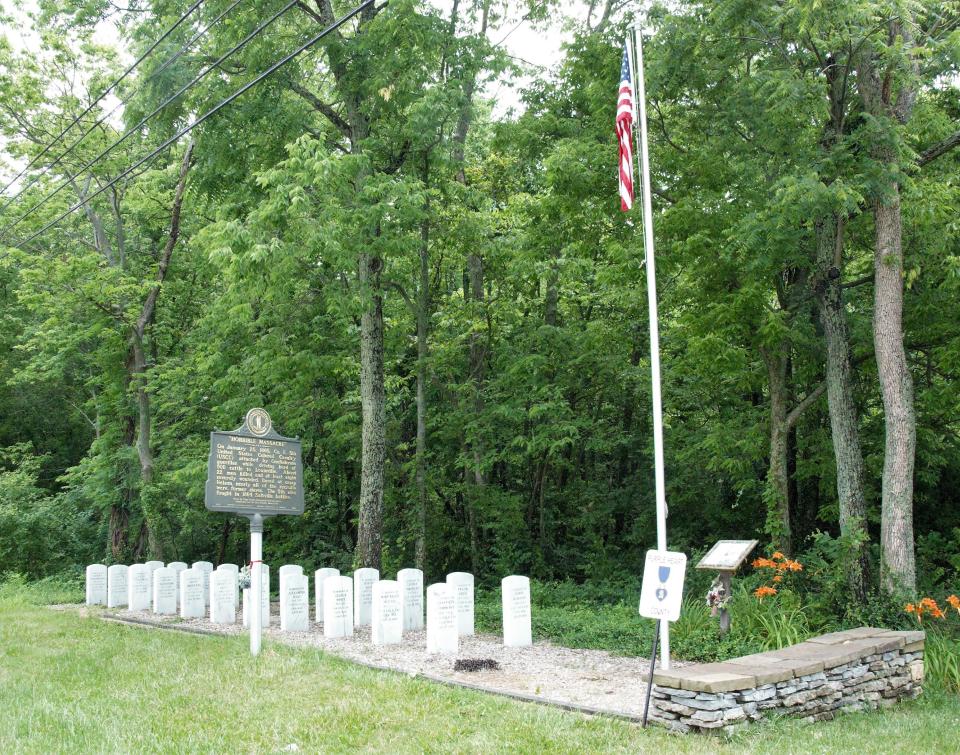The 'Simpsonville Slaughter,' a Kentucky Civil War massacre we tried to ignore | Opinion
Editor's note: this story details historic violence that some may find upsetting. The author also quotes archived newspaper articles from a time period when "Negroes" was standard terminology instead of Black Americans.
"If a race has no history … it stands in danger of being exterminated," warned historian Carter G. Woodson, the “Father of Black History" and the founder of Black History Month.
Confederate guerrillas exterminated approximately 22 Black U.S. soldiers near Simpsonville in Shelby County, Kentucky late in the Civil War. But the “Simpsonville Slaughter” isn’t in most history books because “until fairly recently the efforts — even the existence — of African American troops have been largely ignored,” according to Murray State University historian Bill Mulligan.
A state historical society roadside marker on U.S. 60 west of Simpsonville tells about the Jan. 25, 1865, massacre of the troopers, members of Company E, Fifth United States Colored Cavalry. (The Army designated Blacks as “United States Colored Troops.”)
Flanking the marker are 22 white marble military tombstones, rowed up soldierlike, with names of the fallen men. The Stars and Stripes fly over the site.
Opinion: Remembering Elisha Green's resilience in 1883 Kentucky for Black History Month
Some of the troopers may have been survivors of the October, 1864, Saltville Massacre in Virginia. After the battle of Saltville, some of the victorious Confederates murdered a number of wounded U.S. soldiers, most of them Fifth Cavalry troopers.

“Armed Black men were a Southern white nightmare brought to life,” Mulligan added. "When Black units did engage in combat with rebel forces, very few prisoners were taken. Simpsonville, Saltville and Fort Pillow [Tenn.] are extensions of this killing. Black soldiers were part of the visceral fear of empowered Black men — they were to be slaughtered so as to erase their existence."
The outlaws, on horseback, struck while the horsemen, detailed as foot soldiers, were driving a herd of around 900 cattle to Louisville from Camp Nelson, their base near Nicholasville, the Jessamine County seat. Part of Camp Nelson, the largest recruiting station for African American troops in Kentucky, is preserved in a park, Camp Nelson National Monument.
“About 22 men killed and at least eight severely wounded,” says the olive green metal sign with gold letters. Most of the recruits were former slaves.
Several newspapers in Kentucky and other states reported the slayings, condemning the bloodshed as the “Simpsonville Slaughter.” The mass killings outraged the Louisville Journal. “It is presumed that the Negroes surrendered and were shot down in cold blood,” the paper reported on Jan. 26.
Fifteen guerrillas, armed with six-shot revolvers, surprised the 80 troopers just after they left Simpsonville on a bitterly cold winter day. Snow blanketed the ground.
About 40 soldiers were in front of the herd. A like number trailed the cattle. The men were largely on their own because "their officers stopped to warm at various houses along the road," the Journal said.
The Journal said the guerrillas surprised the rear group and stampeded the herd. “It was a horrible butchery, yet the scoundrels engaged in the bloody work shot down their victims with feelings of delight,” the Journal told its readers.
The paper described the massacre site as “a terrible scene" in which "the ground was stained with blood and the dead bodies of negro soldiers were stretched out along the road.” Local citizens helped tend the wounded and also bury the dead in a common grave. The surviving soldiers managed to escape to Louisville.
Opinion: Want to understand what it means to be anti-racist? Read these books.
“The massacre was largely forgotten in historical accounts until 2008, when the Kentucky African American Heritage Commission awarded a Lincoln Preservation Grant to the Shelby County Historical Society to investigate the Simpsonville Slaughter,” according to The Kentucky African American Encyclopedia. “Locals assumed that the victims of the attack had been buried in a mass grave in a nearby African American cemetery that had been abandoned for 40 years.”
The mass grave couldn’t be found, but the county historical society was able to fund the historical marker which was dedicated on the 144th anniversary of the massacre, says the encyclopedia.

Berry Craig is a professor emeritus of history at West Kentucky Community College in Paducah and an author of seven books and co-author of two more, all on Kentucky history.
This article originally appeared on Louisville Courier Journal: A Kentucky Civil War massacre we almost forgot | Opinion

